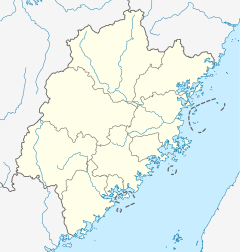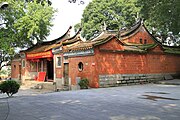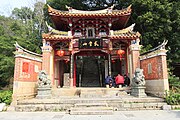Fashi Zhenwu Temple
| Fashi Zhenwu Temple | |
|---|---|
法石真武庙 | |
 Entrance of Fashi Zhenwu Temple. | |
| Religion | |
| Affiliation | Taoism |
| Deity | Xuanwu |
| Location | |
| Location | Fengze District, Quanzhou, Fujian |
| Country | China |
| Geographic coordinates | 24°52′57″N 118°37′00.12″E / 24.88250°N 118.6167000°E |
| Architecture | |
| Style | Chinese architecture |
| Date established | Song dynasty |
| Location | China |
| Part of | Quanzhou: Emporium of the World in Song-Yuan China |
| Criteria | Cultural: (iv) |
| Reference | 1561 |
| Inscription | 2021 (44th Session) |
Fashi Zhenwu Temple (simplified Chinese: 法石真武庙; traditional Chinese: 法石真武廟; pinyin: Fǎshí Zhēnwǔ Miào) is a Taoist temple located in Fengze District of Quanzhou, Fujian, China.[1][2][3] In 2021, the temple was inscribed on the UNESCO World Heritage List along with other medieval sites in Quanzhou because of its religious importance for maritime trade in China during the Song and Yuan dynasties and its testimony to the global exchange of ideas and cultures.[4]
History[edit]
According to Quanzhou Prefecture Topography (泉州府志) and Jinjiang County Annals (晋江县志), the temple was originally built in the Song dynasty (960–1279).[5][2][3] Another says that the temple was first built in the Southern Tang dynasty (923–936).[6]
Architecture[edit]
Now the existing main buildings include Shanmen, Bai Pavilion (拜亭) and Zhenwu Hall (真武殿).[2][3]
Bai Pavilion[edit]
The Bai Pavilion was rebuilt in 1870, during the reign of Tongzhi Emperor in the Qing dynasty (1644–1911).[2][3]
Zhenwu Hall[edit]
Covering an area of 780-square-metre (8,400 sq ft), the Zhenwu Hall was reconstructed in 1842 with single-eave gable and hip roof, in the ruling of Daoguang Emperor in the Qing dynasty (1644–1911). It is the main hall in the temple for worshiping Xuanwu. A modern restoration of the hall was carried out in 1985.[2][3]
Gallery[edit]
-
A side view of Fashi Zhenwu Temple.
-
Entrance.
References[edit]
- ^ 祭海佑民的泉州真武庙. Chinanews (in Chinese). 2017-10-13. Archived from the original on 2018-06-27. Retrieved 2018-06-27.
- ^ a b c d e State Administration of Cultural Heritage (2008), p. 361.
- ^ a b c d e Cao Chunping, Zhuang Jinghui & Wu Yide (2008), p. 69-70.
- ^ "Quanzhou: Emporium of the World in Song-Yuan China". UNESCO World Heritage Centre. United Nations Educational, Scientific, and Cultural Organization. Retrieved 22 Aug 2021.
- ^ 真武庙祭海祈福邀您共赏. 163.com (in Chinese). 2018-03-09. Archived from the original on 2018-06-27. Retrieved 2018-06-27.
- ^ 泉州法石真武庙:海丝祭海保航又一史迹(图). mnw.cn (in Chinese). 2015-11-06.
Bibliography[edit]
- State Administration of Cultural Heritage (2008). 《全国重点文物保护单位》 [Major National Historical and Cultural Sites] (in Chinese). Beijing: Cultural Relics Publishing House. ISBN 978-7-5010-2446-9.
- Cao Chunping; Zhuang Jinghui; Wu Yide (2008). 《闽南建筑》 [Architecture in Fujian] (in Chinese). Fuzhou, Fujian: Fujian People's Publishing House. ISBN 978-7-211-05678-1.




